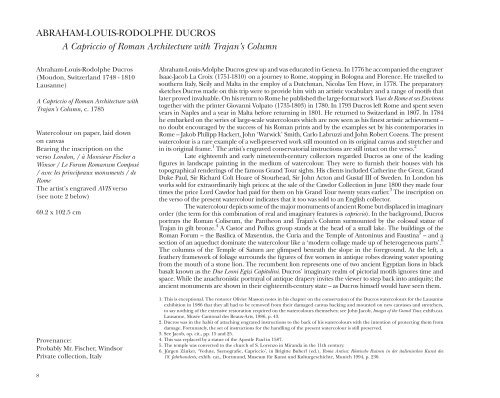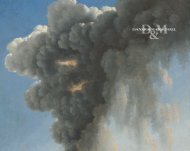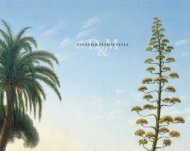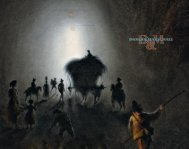Catalogue 2010 - daxer & marschall
Catalogue 2010 - daxer & marschall
Catalogue 2010 - daxer & marschall
You also want an ePaper? Increase the reach of your titles
YUMPU automatically turns print PDFs into web optimized ePapers that Google loves.
ABRAHAM-LOuIS-RODOLPHE DuCROS<br />
A Capriccio of Roman Architecture with Trajan’s Column<br />
Abraham-Louis-Rodolphe Ducros<br />
(Moudon, Switzerland 1748 - 1810<br />
Lausanne)<br />
A Capriccio of Roman Architecture with<br />
Trajan’s Column, c. 1785<br />
Watercolour on paper, laid down<br />
on canvas<br />
Bearing the inscription on the<br />
verso London, / à Monsieur Fischer a<br />
Winsor / Le Forum Romanum Composé<br />
/ avec les principeaux monuments / de<br />
Rome<br />
The artist’s engraved AVIS verso<br />
(see note 2 below)<br />
69.2 x 102.5 cm<br />
Provenance:<br />
Probably Mr. Fischer, Windsor<br />
Private collection, Italy<br />
8<br />
Abraham-Louis-Adolphe Ducros grew up and was educated in Geneva. In 1776 he accompanied the engraver<br />
Isaac-Jacob La Croix (1751-1810) on a journey to Rome, stopping in Bologna and Florence. He travelled to<br />
southern Italy, Sicily and Malta in the employ of a Dutchman, Nicolas Ten Hove, in 1778. The preparatory<br />
sketches Ducros made on this trip were to provide him with an artistic vocabulary and a range of motifs that<br />
later proved invaluable. On his return to Rome he published the large-format work Vues de Rome et ses Environs<br />
together with the printer Giovanni Volpato (1735-1803) in 1780. In 1793 Ducros left Rome and spent seven<br />
years in Naples and a year in Malta before returning in 1801. He returned to Switzerland in 1807. In 1784<br />
he embarked on the series of large-scale watercolours which are now seen as his finest artistic achievement –<br />
no doubt encouraged by the success of his Roman prints and by the examples set by his contemporaries in<br />
Rome – Jakob Philipp Hackert, John ‘Warwick’ Smith, Carlo Labruzzi and John Robert Cozens. The present<br />
watercolour is a rare example of a well-preserved work still mounted on its original canvas and stretcher and<br />
in its original frame. 1 The artist’s engraved conservatorial instructions are still intact on the verso. 2<br />
Late eighteenth and early nineteenth-century collectors regarded Ducros as one of the leading<br />
figures in landscape painting in the medium of watercolour. They were to furnish their houses with his<br />
topographical renderings of the famous Grand Tour sights. His clients included Catherine the Great, Grand<br />
Duke Paul, Sir Richard Colt Hoare of Stourhead, Sir John Acton and Gustaf III of Sweden. In London his<br />
works sold for extraordinarily high prices: at the sale of the Cawdor Collection in June 1800 they made four<br />
times the price Lord Cawdor had paid for them on his Grand Tour twenty years earlier. 3 The inscription on<br />
the verso of the present watercolour indicates that it too was sold to an English collector.<br />
The watercolour depicts some of the major monuments of ancient Rome but displaced in imaginary<br />
order (the term for this combination of real and imaginary features is capriccio). In the background, Ducros<br />
portrays the Roman Coliseum, the Pantheon and Trajan’s Column surmounted by the colossal statue of<br />
Trajan in gilt bronze. 4 A Castor and Pollux group stands at the head of a small lake. The buildings of the<br />
Roman Forum – the Basilica of Maxentius, the Curia and the Temple of Antoninus and Faustina 5 – and a<br />
section of an aqueduct dominate the watercolour like a ‘modern collage made up of heterogeneous parts’. 6<br />
The columns of the Temple of Saturn are glimpsed beneath the slope in the foreground. At the left, a<br />
feathery framework of foliage surrounds the figures of five women in antique robes drawing water spouting<br />
from the mouth of a stone lion. The recumbent lion represents one of two ancient Egyptian lions in black<br />
basalt known as the Due Leoni Egizi Capitolini. Ducros’ imaginary realm of pictorial motifs ignores time and<br />
space. While the anachronistic portrayal of antique drapery invites the viewer to step back into antiquity; the<br />
ancient monuments are shown in their eighteenth-century state – as Ducros himself would have seen them.<br />
1. This is exceptional. The restorer Olivier Masson notes in his chapter on the conservation of the Ducros watercolours for the Lausanne<br />
exhibition in 1986 that they all had to be removed from their damaged canvas backing and mounted on new canvases and stretchers,<br />
to say nothing of the extensive restoration required on the watercolours themselves; see John Jacob, Images of the Grand Tour, exhib.cat.<br />
Lausanne, Musée Cantonal des Beaux-Arts, 1986, p. 43.<br />
2. Ducros was in the habit of attaching engraved instructions to the back of his watercolours with the intention of protecting them from<br />
damage. Fortunately, the set of instructions for the handling of the present watercolour is still preserved.<br />
3. See Jacob, op. cit., pp. 15 and 25.<br />
4. This was replaced by a statue of the Apostle Paul in 1587.<br />
5. The temple was converted to the church of S. Lorenzo in Miranda in the 11th century.<br />
6. Jürgen Zänker, ‘Vedute, Szenografie, Capriccio’, in Brigitte Buberl (ed.), Roma Antica: Römische Ruinen in der italienischen Kunst des<br />
18. Jahrhunderts, exhib. cat., Dortmund, Museum für Kunst und Kulturgeschichte, Munich 1994, p. 230.






